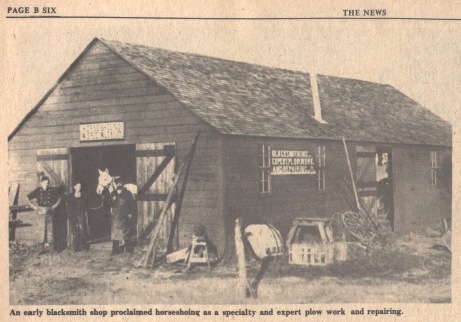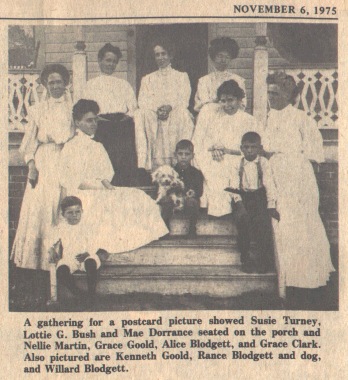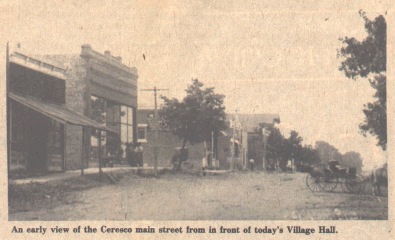Ceresco History Special Section, November 6, 1975. Page 6.
 An early blacksmith shop proclaimed horseshoing as a specialty and expert plow work and repairing. A parsonage was erected that first year for Rev. C. O. Granlund. Morning services were held in Swedish and evening services were in English. In 1920 all regular services were conducted in English. A $3000 pipe organ was dedicated in 1923 and in 1929 an indebtedness of $1118.57 was paid off by a free-will subscription one evening amounting to $1137.00. In 1963 the Augustana Lutheran Church, merged with the American Evangelical Lutheran Church, the Finnish Evangelical Church and the United Lutheran Church in America and became the Lutheran Church in America. Rev: Richard Woolard currently serves as pastor. The Evangelical Covenant Church, formerly the Swedish Mission Church, was organized on January 1, 1906 when a group of Swedish immigrants met at the Herman Nyquist home. Nyquist, Sam S. Johnson and August Dahlstrom were appointed to find a place to worship regularly and the Presbyterian Church at that time was rented for $3.00 per month. Rev. P. F. Mostrom served as the first pastor. Members of the church on April 10, 19,06 included Rev. and Mrs. P. F. Mostrom, Gideon and Hilda Franzen, Mr. and Mrs. Herman Nyquist, Mr. and Mrs. Sam S. Johnson, Sadie Anderson, Mr. and Mrs. August Dahlstrom, Emma Mostrom, Amy Mostrom, Mr. and Mrs. G. E. Johnson, Karl Anderson, Mr. and Mrs. John Martinson, Mr. and Mrs. Otto Johnson, Christian Dahlstrom. Added later were Mr. and Mrs. Charlie A. Johnson, Carl Johnson Arthur Johnson, Charles Ericson, Mr. and Mrs. Andrew Oakeson and Mr. and Mrs. John Malmgren. A new church was built in the fall of 1906 for $4,363.52 and a parsonage added in 1912 for $2,623.67. In mid-1973, nearly 67 years later, bids were let for another new building estimated to cost $150,000. Currently serving the church is Rev. Everett Wilson.  A gathering for a postcard picture showed Susie Turney, Lottie G. Bush and Mae Dorrance seated on the porch and Nellie Martin, Grace Goold, Alice Blodgett, and Grace Clark. Also pictured are Kenneth Goold, Rance Blodgett and dog, and Willard Blodgett. The Presbyterian Church was organized in 1888 and the church was built in 1890. Due to the death of so many of its members and others moving away, the Presbytery sold the building which was made into a house. An October 31, 1932 fire at the oil storage tanks of the Farmers Union Oil Company was confined to those tanks in spite of burning out of control for many hours. A southwest wind blew the heat and smoke, visible for many miles, away from town. High powered rifles from the Lincoln Police Department were used to puncture the tanks to drain them. A fire at the top of the old Co-op elevator in 1941 was extinguished by firefighters in time to prevent major structural damage. Through the years new buildings have replaced many of the old buildings. In 1948 the American Legion Memorial building was completed and a medical building, now the Village Hall, was built through community donations in 1951. The first fire truck was purchased in 1940 for the volunteer firemen and is still operating today. In 1955 another truck aws added by the rural fire district. A water tanker truck began being used in 1962. A first aid rescue unit was organized in 1968 and a rescue vehicle was purchased. In 1947 the community bought its first Auto Patrol Grader to care for its streets. The village dump was closed in 1951 and a haul-type garbage collection system was instituted. The Lagoon Sewage System was constructed in 1954 at a cost of $51,000 and the next year a new village well was drilled. Mercury vapor lights were installed along the main street in 1956 and the streets were paved with armor coat the same year. Today the village is faced with a problem involving their water system that will require the spending of hundreds of thousands of dollars. Besides not meeting the needs of a growing population the two existing wells contain nitrates at a level higher than acceptable by the Environmental Protection Agency for health standards. A 40,000 gallon storage tank built in 1915, in combination with. the low-yield wells, is proving to be inadequate. Many water mains are too small or on deadend lines and cannot deliver water most efficiently. A new well field is being sought and plans are being formulated to improve the entire system. A lighted park featuring shelters, picnic table, playground equipment, a lighted ball field and restrooms was completed in 1973. A summer and winter recreation program involves many of the town's younger people. Community organizations include the American Legion and Auxiliary, booster Club, Commercial Club, Eastern Star Chapter, Masonic Lodge, Nebraska Community Improvement Program, and Planning Commission. A Bicentennieal Committee formed to organize activities in Ceresco for the nation's 200th birthday is headed by Donald Johnson with Hazel Burklund as Heritage Chairman, Mary Maxson as Festivals chairman, and Charles Nelson as Horizon Chairman. On October 26, 1975 Ceresco became the 173rd Nebraska community to be recognized as an American Bicenteanial Community and the town received the official flag which it is now authorized to fly. A special project of the committee is a plan to plant trees that will still be living along the main streets in 2076.  An early view of the Ceresco main street from in front of today's Village Hall. |
